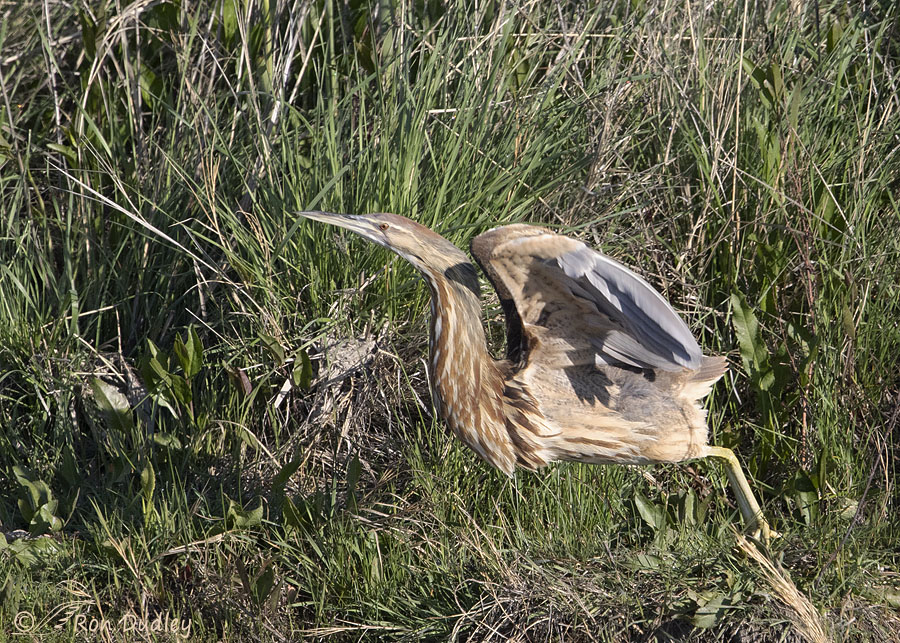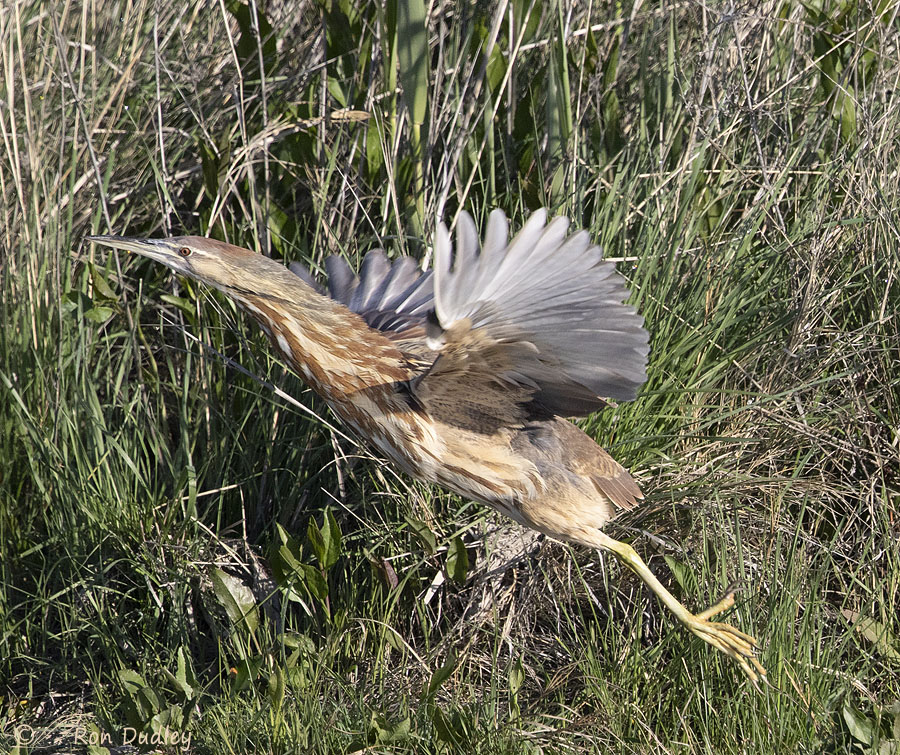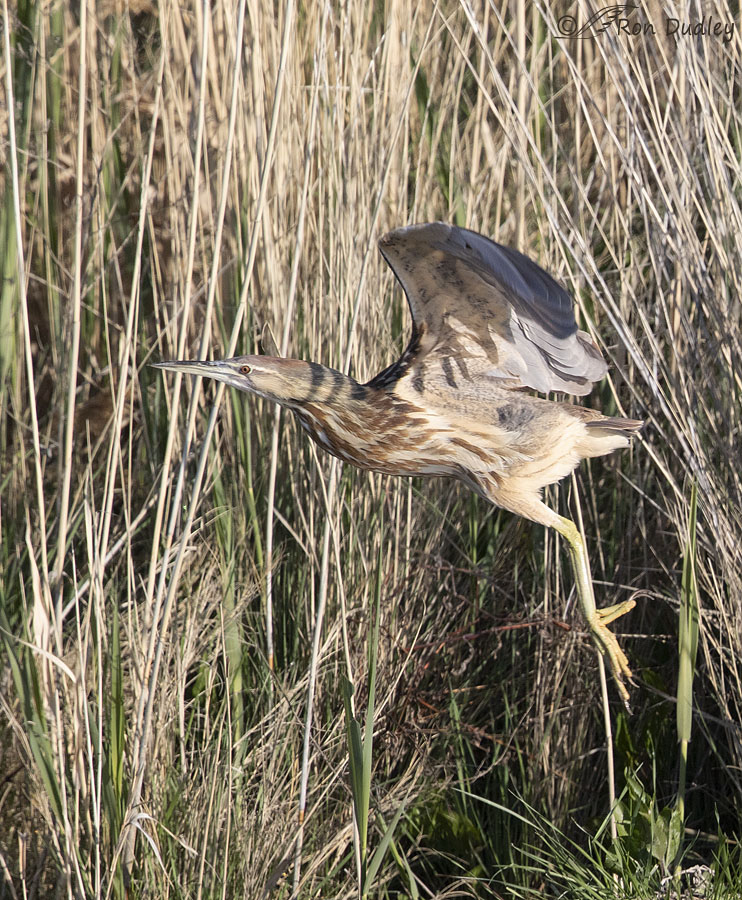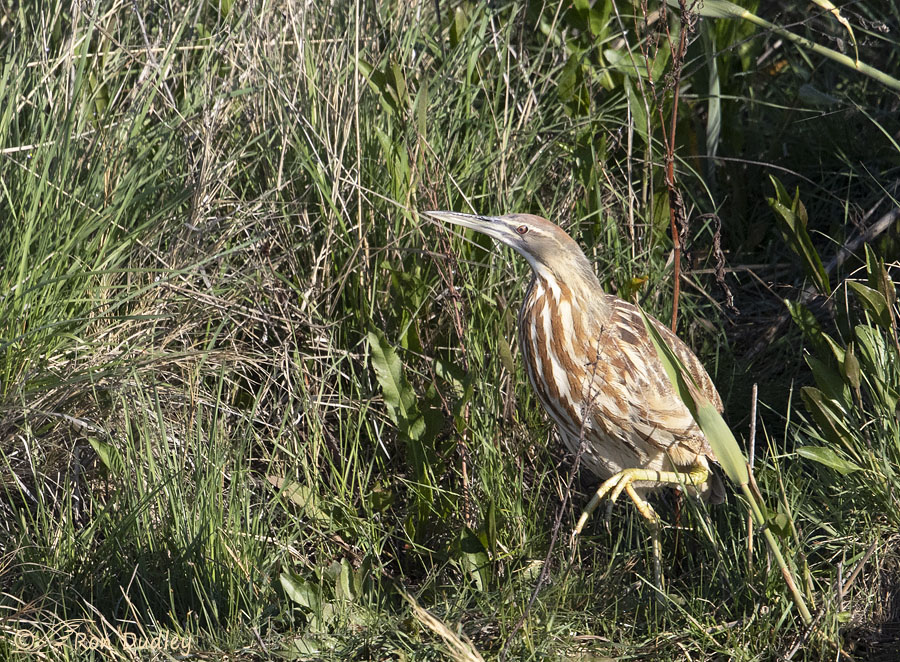The American Bittern is solitary and cryptically colored. Throw in its secretive nature and inaccessible habitats and you have a species that I rarely see so getting photos of one taking off and in flight made my day yesterday.
1/2000, f/7.1, ISO 800, Canon 7D Mark II, Canon EF 500mm f/4L IS II USM + EF 1.4 III Extender, not baited, set up or called in
When I first spotted “him” yesterday morning at Bear River MBR he was close but on the wrong side of my pickup for photography. As I tried some creative driving to get him into my viewfinder he flew to the far side of the canal and mostly buried himself in the vegetation. Here he’s beginning to slowly come out, as evidenced by that huge, raised foot.
All of these photos have a close and busy background but it’s typical habitat for the species so I can live with it.

1/2000, f/7.1, ISO 800, Canon 7D Mark II, Canon EF 500mm f/4L IS II USM + EF 1.4 III Extender, not baited, set up or called in
I soon learned why he came out into the open – his intention was to go elsewhere.

1/2500, f/7.1, ISO 800, Canon 7D Mark II, Canon EF 500mm f/4L IS II USM + EF 1.4 III Extender, not baited, set up or called in
I call this shot “The Big Stretch”. In this photo and the following one I didn’t have enough room in front of the bird for a composition I like but at least I didn’t clip any body parts.
One thing surprised me about this shot. I wasn’t particularly close to the bird so at f/7.1 I expected to have enough depth of field to get the wings sharp, even with them in this position. But they’re soft. That tells me that they’re probably soft because of motion blur due to insufficient shutter speed when I expected 1/2500 sec to be plenty fast for such a large bird. Live and learn.

1/2500, f/7.1, ISO 800, Canon 7D Mark II, Canon EF 500mm f/4L IS II USM + EF 1.4 III Extender, not baited, set up or called in
I was able to get four shots of him in flight and the two I’ve included here were my favorites, despite their compositional issues.
American Bitterns are at or near the top of my list of most elusive species for photography. I can probably count on one hand the number of times I’ve seen one out in the open and been able to get reasonably good photos so this bird made my morning.
Ron



Fingers on wrong keys … David Sparks
Those second and fourth shots especially are stunners! All the shots have quite the WOW factor. So cool to see this elusive species. 🙂
Thanks, Marty. I’m glad you like them.
Great shots, I see so much clearer now and colours are brighter. I have not seen an American Bittern in years, love the still shots and the take-off.
Thanks, Jane. Sounds like your cataract surgery had good consequences for you. Congrats!
I rarely see photos of American Bitterns in flight. Neat captures. It seems to me that photos of the birds make them appear less elusive than they really are. I remember a day when I had my camera and tripod set up with the bird in focus waiting for the bird to move or fly. Someone came up and asked me what I was viewing. When I tried to point out the bird to the person, I could not find it. But when I looked through the viewfinder, it had not moved.
Similar things have happened to me, Davud, with a variety of species including bitterns.
The J. D. Salinger of the avian world! Terrific photos!
Yup, just as reclusive and just as obsessively private. Thanks, Dale.
As a direct descendant of Big Foot it was those feet which caught my eye.
And the skilled camouflage.
Great shots despite the ‘softness’ which also serve to show its preferred habitat.
You make me laugh, EC. Thank you.
Ron, what a long neck, long bill and long legs this bird has. Just wonder how much time you waited and then spent getting these photos. Glad to see how pleased you are with the results, which is warranted, in my book. Thank you, Ron
Thankfully I didn’t have to wait long for him to come out after he landed there, Alice. The biggest challenge was maneuvering my pickup so I could get him in my viewfinder.
Nice find and images, Ron. I feel lucky if I can get just one photo-op with this species each winter. They are such masters of disguise. I actually had one gradually disappear before my eyes as I barely saw it moving. Once saw one out in the open in a parking lot. It used the same technique of moving extremely slowly as if it were hidden by weeds. It was comical!
Thanks, Ken. I think I’ve had less than one encounter with them per hear in the ten years I’ve been photographing birds.
The wings appear stubby in comparison to the body. Is that just me seeing this on a small screen?
I’d say you’re right, Arwen I think they’re akin to the wings of many upland game birds. I suspect it’s an adaptation for living in the dense vegetation they prefer as habitat. And it might account for their unexpectedly rapid wingbeats that made the wings soft in some of my photos.
Makes sense. Too much wing and there would be a problem. Thanks!
Cool find! I think the second photo really shows how long the bird’s neck is compared to its body. When it is just standing there, it’s difficult for me to tell where the neck stops and the body begins.
Thank you, Aidan.
Love it, “Creative Driving” to get into position. And you did it. Beautiful series of photos in very dense vegetation. So neat to see the progression of the wings from zero to full extension. Very nice.
Everett Sanborn, Prescott AZ
I could write a short book on creative driving while photographing birds, Everett. I think I’ve become pretty good at it…
Great photos…just love those feet and legs. Catching the take off is certainly special. Always a pleasure to watch…sometimes waiting to see who will blink first…and that swaying…makes one smile. Love their ‘ker-lunking’ sounds echoing across the marsh. Patience is the key to waiting for them to emerge and if you are lucking catching a Sora or two. They are back here for the season now so the night time bedding down music through the marsh is wonderful.
Kathy, soras are one of the very few birds I think are at least as elusive ad bitterns. Thank you.
Leave it to you to get these photos away from its camouflage habitat and springing into action. Those feet put a velociraptor to shame for length. The one time I saw one we stood their transfixed for the longest time watching it move waaay slower than molasses through the reeds. A mesmerizing slo-mo movie in real time.
Yes, it’s pretty interesting to watch them move through thick vegetation, Lyle. I think it’s a great cryptic strategy.
You’re way too harsh a critic of your own photos, Ron. I’ve seen these several times in Florida and I’ve never made a photo of them in flight nearly as good as yours.
I’m happy to have these photos, Ed. But I can sure see room for improvement.
Sensational series of this elusive bird Ron! KUDOS!!
Charlotte
Thanks, Charlotte.
Well done, Ron! I love when they sway ever so gently with the reeds, giving them perfect camouflage. I was listening to one “sing” for nearly 30 minutes in a marsh on Sunday and never did see him. Pure joy!
Yup, that rhythmic swaying is fascinating to watch. Thanks, Diane.
Nice – soft wings and all! 🙂 Glad it gave you a clear shot! Don’t believe I’ve ever seen or heard one tho, in theory they can be here in summer…. Guessing lack of marshy areas in the immediate area and not paying attention? Last photo looks like it’s just “hanging there”….. 😉
Judy, you mentioned “hearing one”. Hearing one call is something I don’t think anyone forgets. This from BNA Online about their calls:
“These calls have an eerie, ventriloquistic quality, and many vernacular names for this species, including “stake-driver,” “thunder-pumper,” and “mire-drum,” alludes to these calls.”
Went out to Cornell and listened as, often, I’ve heard a bird rather than seen it – not that one! It is different! 🙂
Wow, Ron – these are spectacular captures that I agree with you on how difficult it is to even see them!! I’ve only seen one once at Green Cay & the only reason I did was another photographer had told me the area he’s seen one. Even when I came to the spot I almost missed him, I had to stare at the area & THEN finally saw movement & there he was!!!
Jo Ann, more than once when I’ve seen a bittern and looked away for a moment I then couldn’t relocate it even though the bird hadn’t moved. They’re the epitome of cryptic.
Wonderful photos of a bird that frequents messy places and tries to blend right in!
Thanks, Nancy. Just seeing a bittern is special for me so I was pretty happy to get these shots.